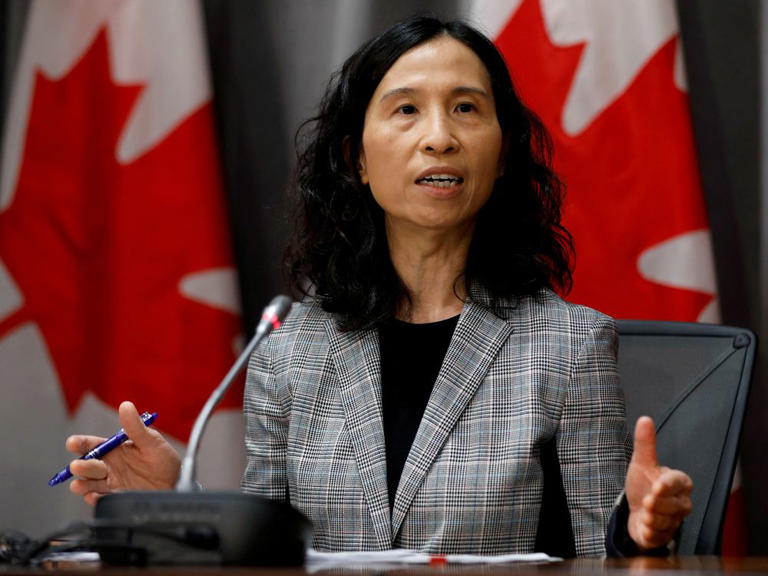Public Health Agency looks to revamp national stockpile for a future disaster
Story by Ryan Tumilty •1d
POSTMEDIA

Chief Public Health Officer Dr. Theresa Tam attending a news conference in Ottawa.© Provided by National Post
OTTAWA — With the pandemic largely in the rear-view mirror, Canada’s public health agency is looking to reshape the country’s emergency stockpile in the hopes it will be better prepared for whatever the next calamity to hit the country will be.
The National Emergency Strategic Stockpile (NESS) was created in the 1950s and began as a warehouse for iodine tablets, shelters, tents and the kind of items Canada might need after a nuclear attack. It evolved over time, stocking vaccines and medicines for rare diseases and focusing more on bio-terrorism than a nuclear strike.
When the pandemic hit in 2020, the stockpile was not up to the job, with inadequate supplies for the sudden massive demand for personal protective equipment, an inefficient inventory system and revelations that the government had actually thrown away millions of masks the year before.
Auditor General Karen Hogan criticized Public Health for being caught short when the shortfalls were well known.
Government officials say national stockpile not designed for pandemic: 'We do not focus on PPE'
“As a result of long-standing, unaddressed problems with the systems and practices in place to manage the National Emergency Strategic Stockpile, the Public Health Agency of Canada was not as prepared as it could have been to respond to the surge in provincial and territorial needs brought on by the COVID‑19 pandemic,” Hogan wrote in 2021.
In a recent interview, Dr. Theresa Tam, Canada’s chief public health officer, said with the pandemic now considered over, the agency is aiming to present a new plan for the NESS by next spring.
She said the pandemic drastically increased the size of the stockpile, which had just 170,000 square feet of supplies before COVID-19.
“We went to three million square feet at the height of the pandemic, and now we’re at 1.7 million square feet, which if you want to think about it is 100 hockey rinks,” she said.
Citing security reasons, the agency won’t reveal the locations of the warehouses full of supplies or allow site visits by journalists, but Tam said the facilities now have an electronic inventory system and are better supplied for future crises.
Having a better handle on the inventory was a recommendation made in several audits before the pandemic to prevent waste. Tam said they’re hopeful they are going to be able to do that, but she acknowledged that there will be some waste.
“Decision-makers need to understand there will be some; you want to minimize any kind of wastage, but there will inevitably be some for several reasons,” she said.
Tam said the new stockpile will have a lot more personal protective equipment, but her agency is also working with the provinces to set clearer expectations about what they can reasonably expect.
“We provide a surge to the provinces and territories at their request, but, of course, we’re also expecting them to be prepared in a reasonable manner to most emergencies and that requires a level of dialogue and a common consensus,” she said.
Tam said as they decide what the stockpile will hold, they’re paying closer attention to where items are manufactured. Karen Walton, a director with the NESS, said when something is manufactured in only one country and could be critical in an emergency they want to ensure Canada has a robust supply.
“If it’s concentrated in a certain part of the world, and there’s not many manufacturers, you create potentially a variable approach in terms of how much you potentially need to stockpile to mitigate that.”
Canada was not alone in dealing with problems with its emergency stockpile during the pandemic, with many countries finding their supplies were wasted or inadequate.
During the pandemic, researchers Scott Laing and Ellen Westervelt, writing in the Canadian Medical Association Journal , called on the government to scrap the system and create instead a “prime vendor” system where the government would buy materials and then ship it to hospitals, holding back enough for a stockpile.
“The prime vendor would keep stockpile warehouses full and sell supplies to hospitals, private clinics and long-term care facilities for routine use, thereby keeping stocks fresh and ensuring adequate supply for emergency responses,” the study suggested.
Tam said the new plan for the NESS will examine all options.
Before the pandemic, Canada made virtually no personal protective equipment, buying all of it, mostly from China. The government has since awarded large contracts and grants to companies to make PPE here at home.
Tam said fixing the issue will require a country-wide effort to keep those manufacturers in place so Canada isn’t caught off guard again.
“It demands that the whole health system, and not just the federal government, which doesn’t consume a lot of these things, but the provinces and the territories as well to buy into the concept that domestic supplies are part of the strategy.”
Twitter: RyanTumilty
Email: rtumilty@postmedia.com
No comments:
Post a Comment